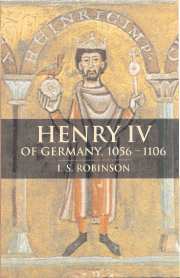Book contents
- frontmatter
- Contents
- Acknowledgements
- INTRODUCTION
- THE YOUNG KING, 1056–1075
- THE CONFLICT WITH POPE GREGORY VII
- 3 Henry IV, the imperial Church and the reform papacy, 1065–1075
- 4 Worms, Canossa, Forchheim, 1076–1077
- 5 Civil war in Germany, 1077–1081
- 6 The second Italian expedition, 1081–1084
- EMPEROR HENRY IV, 1084–1106
- CONCLUSION
- Bibliography
- Index
4 - Worms, Canossa, Forchheim, 1076–1077
from THE CONFLICT WITH POPE GREGORY VII
Published online by Cambridge University Press: 18 July 2009
- frontmatter
- Contents
- Acknowledgements
- INTRODUCTION
- THE YOUNG KING, 1056–1075
- THE CONFLICT WITH POPE GREGORY VII
- 3 Henry IV, the imperial Church and the reform papacy, 1065–1075
- 4 Worms, Canossa, Forchheim, 1076–1077
- 5 Civil war in Germany, 1077–1081
- 6 The second Italian expedition, 1081–1084
- EMPEROR HENRY IV, 1084–1106
- CONCLUSION
- Bibliography
- Index
Summary
The papal ultimatum was delivered to Henry on 1 January 1076 in Goslar. There the king had held an assembly concerned with the fate of the defeated Saxons and the succession of his son Conrad. At the moment when the pope threatened to deprive him of ‘both soul and kingdom’, Henry seemed more powerful than at any time since his accession. For the first time since the reform papacy began to interest itself in his advisers and his conduct towards the Church, Henry was freed from the need to dissemble his response. The king's reaction to the pope's message was to turn to the excommunicated advisers. It was on their advice that the king summoned a council to meet in Worms on 24 January 1076. The council had the character both of an assembly of princes and of a synod. Henry himself described it as ‘a general assembly of all the princes of the kingdom’. It was attended by the archbishops of Mainz and Trier, twenty-four of the thirty-eight German bishops and one Burgundian and one Italian bishop, together with numerous abbots. Of the secular princes the sources identify by name only Duke Godfrey III of Lower Lotharingia, believed by the south German chroniclers to be ‘the author of the conspiracy’ of Worms. Godfrey certainly enjoyed the king's trust, alone among the secular princes.
- Type
- Chapter
- Information
- Henry IV of Germany 1056–1106 , pp. 143 - 170Publisher: Cambridge University PressPrint publication year: 2000



